Fibreguide Ltd., England, has extended and improved its range of single- and multi-position
interlacing air jets. The range now consists of 11 different air-jet types, including Detorque,
Detorque with interlace and oil dispersion jets. In addition, the company offers a wide range of
Interlace jets for the production of all types of continuous filament yarns, ranging from
micro-denier yarns up to BCF and industrial applications. Low-noise jet enclosures have also been
introduced to enhance the interlacing performances of the multi-position FG2M and FG10M air-jet
units, as well as the individual FG4 Jet.
2000
New Air Jets Provide Cost Savings In Air Consumption
Rimoldi Presents Cup Seamer
The 255-00-01 cup seamer from Pittsburgh-based Rimoldi of America Inc. is a one-needle, double
chain-stitch machine with cup seamer feeding for assembly seaming fully fashioned knitwear with
10-5 mm gauge.Features include feeding with counter-rotating cups synchronized individually with
two separate motors; button-adjustable stitch length; chain-stitch pulling device, with rollers,
built into the sewing head; and a pumped lubrication system.
2000
Ahlstrom Completes Acquisition Of Dexter
Ahlstrom Paper Group, The Netherlands, a subsidiary of Ahlstrom Corp., has completed the
acquisition of Dexter Nonwoven Materials, Windsor Locks, Conn. Ahlstrom received Dexter shareholder
approval and regulatory approval from the European Union, the United States and other national
agreements, allowing for completion of the transaction.Ahlstrom and Dexter are examining how best
to integrate their businesses, and the process should be complete in early 2001. There will be no
immediate changes in conducting business. Because of the complementary nature of their operations
and increasing demand from the market, nonwovens units and employment in both organizations will
remain unchanged.
November 2000
Textile Testing For Quick Response
Textile Testing For Quick Response
New equipment from Habotex, Raitech accelerates testing time and improves accuracy.Quick
response and just-in-time delivery, hackneyed watchwords for the past decade, become increasingly
important as textile suppliers and purchasers alike seek to shorten the supply-side pipeline.
Quality considerations, mandated by the International Organization for Standardization (ISO), have
forced suppliers to update testing methods, explore opportunities for more rapid testing and
develop entirely new test methods. Organizations such as the American Association of Textile
Chemists and Colorists (AATCC), the German Standards Institute (DIN) and the Society of Dyers and
Colourists (SDC), have joined with the ISO to develop and implement test methods to measure, for
example, percent extractables after preparation, colorfastness after dyeing, and residual chemicals
following finishing.This report covers updates in two important areas: extraction of residual
unreacted chemicals and unremoved chemicals, and prediction of shrinkage and colorfastness to
repeated home laundering.The cost of purified water, steam and utilities in general forced European
textile mills to seek methods for improved preparation, while using a minimum of utilities. The
water used during washing was cut drastically to reduce the load to wastewater treatment, as well
as total energy requirements. Washers were redesigned to use more enhanced mechanical energy in
place of expensive thermal energy to remove contaminants from fabric. Attempts to continuously
ex-tract residual chemicals in real time were met with repeated frustration as streaks and face
deformation made unsaleable goods. The need for rapid testing still existed, and laboratories were
not always close by on the machine floor. Several ideas were evaluated before the first portable,
rapid-extraction units began to appear about five years ago.The Morapex A System And S System
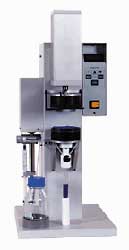
The Morapex A95 and S95 systems, developed by Hans Bors of Switzerland-based Habotex,
gradually have made their way across Europe into textile mills, chemical supplier laboratories and
research institutes. The A unit was developed to offer easy, efficient and complete rapid aqueous
extraction without damage to the material being tested. The S unit was developed with DuPont
Teflon® coatings to handle all solvents. A pre-cut sample of fabric is not required.The A test
unit, which weighs only 8 kilograms (17 pounds), was de-signed to be carried or rolled onto the
factory floor. Once at the processing machine, an end from the latest piece of fabric processed is
placed between the two extraction heads. Approximately five milliliters of the eluting solvent is
then pumped from a small storage bottle to the center of the fabric and then radially through the
sample for a time ranging from 30 seconds to five minutes. The extraction solvent is then collected
in a channel around the edge of the lower head by suction and returned to a small test tube. The
extract captured in a test tube can be either visually examined for color or tested for pH, starch,
etc., by the usual tests. If a dyed and washed sample still has residual unfixed dye, the washing
conditions can be changed immediately without wasting time or continuing to process goods that
would have to be rehandled. More than 200 units of the A95 and A99 have been sold around the world
to textile firms, chemical suppliers and research and university laboratories. Only a few have been
sold in the United States.The improved A99 appeared recently and is being offered in the United
States. The new model contains three separate solvent bottles and provides computer-programmed
extraction temperature (20-98°C), processing time (0.5-5 minutes), and repeat extraction up to 250
processing steps all while maintaining the lightweight, portable features of the A95. Water- and
perspiration-fastness tests can be completed in one to two minutes compared to four hours in the
laboratory. Residual alkali, acid, salts, size, peroxide, and formaldehyde can all be removed and
evaluated. Because of the flexibility of the new model, a rapid simulation of all wet-processing
(for example, desizing, scouring, and bleaching) can be evaluated on a new fabric sample before
running a trial on full-scale equipment.A new test for residual formaldehyde can be completed in
approximately 20 minutes. The formaldehyde-containing extract is combined with an acetyl acetone
reagent and held for 10 minutes at 60°C in an electrically heated thermal block or in a water bath.
Residual formaldehyde forms a yellow complex that can be visually compared with a standard or
quantified at 412 nanometers using a transmission spectrophotometer. The test results compare to
the results obtained with the standard Japanese Law Method (En ISO 14184-1).The S99 model with
Teflon coating is designed for use in a laboratory for more robust extraction with all kinds of
acids, alkalis and solvents at 20-150°C, with cycle times of 0.5-41 minutes. Polyester/cotton
burn-outs can be achieved in minutes. Three two-minute extractions (six minutes total) with
70-percent sulfuric acid or phosphoric acid at 80°C gives results comparable to a 60- to 90-minute
laboratory process in a beaker. The shade of the remaining polyester is unaffected by the
extraction because of the short duration of the extraction.New applications for this portable
extraction technology are constantly being developed in other industries. For example, food
processors can quickly extract fat from sausages to ensure top quality; superabsorbent polymer
manufacturers can quickly determine saturation values; and residual formaldehyde can be determined
by major clothing stores without destruction of incoming merchandise. The applications are
endless.Quickwash Plus Fabric Testing System

Rapid response has mandated that processing times be reduced in the textile mill and in the
laboratory. Dimensional change testing was studied in the middle 1990s at the Swedish Institute for
Fiber and Polymer Research. A prototype machine was brought to the United States in 1997 and
commercialized by Raitech Inc., Charlotte, N.C., under the Quickwash Plus name. At the time, the
AATCC Test Method 61-1996 Wash Test and the AATCC TM 135-1995 Home Laundering Test required hours
to run samples through five cycles. Could an accelerated test be developed in each of these areas
that would be acceptable to the industry After several years of evaluations by Cotton Incorporated,
Cary, N.C., using various cotton fabrics, five different cotton dye class systems, and several
problem shades, the answer is yes. The Quickwash system could generate levels of fabric color
change that were similar to those generated in five home laundry tumble dry (HLtd) cycles. The
Quickwash program for shrinkage runs in 15 minutes; the wash test is complete in one hour, plus
five minutes to measure dimensional change, or 15 minutes to condition prior to color change
evaluation. This compares to nine hours required for AATCC TM 135-1995.In response to the testing
at Cotton Incorporated, AATCC Committee RA42 developed a new test method TM 187-2000, Dimensional
Changes of Fabric: Accelerated which has been accepted by JCPenney, MarksandSpencer plc and other
retailers. The accelerated dimensional change results are achieved by testing a relatively small
190-by-190-millimeter (8-by-8-inch) fabric sample at high rates of wetting, agitation, extraction
and air drying without the use of detergent. A microprocessor-based controller allows
preprogramming of each component of the test cycle to create custom test programs for a wide
variety of fabrics of different constructions and densities. By the summer of 2000, more than 250
companies involved in knitting, weaving, dyeing and finishing, cut and sew, and retail had
purchased Quickwash Plus units.Raitech has developed a line of Quick products for in-lab testing
and fabric sample evaluation. These include: Quickdry, which dries the resulting wet samples in
minutes; Quickcut, which precisely cuts test samples in an automatic press; Quickpunch, which
punches precise, die-cut samples; Quicktemp, which precisely blends and controls wash-water
temperatures for washing machines; and Quickview, which allows quick and accurate measurement to
evaluate shrinkage.The demands of the industry have once again been met with new technological
advances that help improve response time, while improving accuracy and repeatability.
Editor’s Note: Gary N. Mock, Ph. D., is a professor of textile engineering, chemistry and
science at the College of Textiles, North Carolina State University, Raleigh, N.C.
November 2000
China Opportunity Or Threat
China: Opportunity Or Threat
Serious questions linger over the benefits to the U.S. textile industry of normal trade
relations with China.The decision by the United States to grant permanent normal trade
relations (Ntr) to China and that countrys expected entry into the World Trade Organization (WTO)
later this year has, perhaps, engendered more heated debate than any other trade issue in recent
memory. The issue transcends politics, geography and industry. It has staunch allies pointing their
fingers at each other and embittered rivals speaking in a unified voice. It is the salvation of
American agriculture and high-technology industry, or the death of smokestack America, depending
upon which side is talking. It is an issue that has economic, political and moral ramifications. It
at once sets up a clash of two radically different cultures and offers the opportunity for mutual
growth and understanding.And it is a definitive example of the fair trade versus free trade
argument.For those few readers who, perhaps, tucked their heads under the sheets several years ago
in hopes that they would wake up to find the issue had just gone away, following is some background
on how the whole situation evolved.What Is Ntr
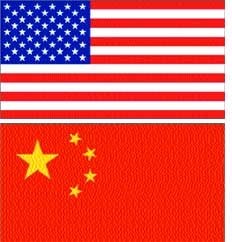
First of all, a definition: Ntr refers to the general tariff treatment the United States
extends to foreign nations in return for reciprocal tariff treatments for U.S. exports. Ntr, also
known as most-favored-nation trade status, is accorded by the United States to more than 130
countries throughout the world. In fact, only six nations Afghanistan, Cuba, Laos, North Korea,
Serbia-Montenegro and Vietnam dont enjoy the designation.The United States has even more favorable
agreements in place with a number of nations, most notably its North American Free Trade Agreement
(NAFTA) trading partners.The United States suspended Ntr for China, the Soviet Union and all
countries in the then Sino-Soviet bloc in 1951. Ntr tariff status was restored conditionally to
China in 1980 under Title IV of the Trade Act of 1974, despite Chinas noncompliance with a key
amendment to the act. The Jackson-Vanik Amendment, targeted primarily to the former Soviet bloc,
specified that Ntr may not be granted to any non-market economy that restricts free emigration,
unless the President of the United States waives the restrictions for certain specified reasons.
From 1980 until now, the granting of Ntr status to China had to be renewed on an annual basis,
based on having a bilateral trade agreement in place and a Presidential waiver of the Jackson-Vanik
Amendment. President Clinton last renewed the waiver for China in June of this year. The current
bilateral trade agreement with China is in force until next year.A hotly debated bill granting
permanent Ntr status to China passed the U.S. House of Representatives in May. The Senate passed
the measure in September.The granting of normal trade status was among the last of Chinas obstacles
in its quest for membership in the WTO. Founded in 1995, the WTO is the successor to the General
Agreement on Tariffs and Trade (GATT), estab-lished after World War II. The mission of the
organization is to monitor global trade rules and ensure orderly and fair implementation of trade
agreements.Chinas accession to the WTO is heralded by China/WTO supporters as a boon for the
economies of the worlds developed nations. With its huge population and heretofore-untapped market,
there is opportunity for considerable export and prosperity. Opponents argue that, while China does
indeed represent opportunity, reality is a different matter. China, they say, has made a mockery of
its trade agreements in the past, refusing to remove barriers to exports while engaging in illegal
product dumping to its trading partners.This, of course, is a somewhat oversimplified picture of a
very complex trade issue. And it doesnt take into account at all the delicate subjects of human
rights and the morality of purported free trade with a nation that, from the American viewpoint,
oppresses and sometimes massacres its own people.ATMI Opposition
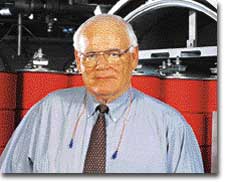
Within the U.S. textile-apparel complex, there are several issues with which industry leaders
take exception.In 1995, all WTO members had to face a 10-year period during which the United States
would phase out its quotas on textile and apparel imports, said Roger W. Chastain, CEO of Mount
Vernon Mills, Greenville, S.C., and president of the American Textile Manufacturers Institute
(ATMI). China, on the other hand, would only have to face a five-year phase. As well, Chastain said
China continues to refuse to open its market to U.S. textile and apparel products, continues to
violate U.S. intellectual property rights and continues to illegally smuggle textiles and apparel
into the United States.The WTO has been ineffective in enforcing the bilateral and multilateral
agreements under which its members trade, he said. Citing a report entitled Promises Unkept: A
Report on Market Access for U.S. Textile and Apparel Products Five Years into the World Trade
Organization, a study commis-sioned by ATMI and completed earlier this year, Chastain said the WTO
has not provided market openings it promised, and the U.S. government has not taken action to open
those markets.The report takes an in-depth look at 27 textile- and apparel-exporting countries and,
according to Chastain, found that only four are open to U.S. textile and apparel products. Each of
those four were already open before the WTOs creation.This report shows what weve already known for
a long time the U.S. textile industry is doing business in an unethical, inequitable world,
Chastain said.The report cites numerous examples of how U.S. trading partners have circumvented the
intent of WTO and specific bilateral trade agreements. The United States, for example, granted
India increased access to its market, an action worth hundreds of millions of dollars, in exchange
for limited access to the Indian market. The report states India made the agreed tariff cuts but
then imposed special countervailing duties, citing balance-of-payment protocols against all of the
agreed-upon products. The result, according to the ATMI report, was a five-year escalation in
Indian imports, totaling $832 million, a 56-percent increase. Meanwhile, U.S. textile and apparel
imports to India remained under $20 million. The ATMI report cites similar circumventions of
agreements by other countries.Five years into the WTO, at least 16 major exporting countries,
including India, Pakistan, Egypt and Thailand, have failed to meet their WTO obligations and open
their markets to U.S. textile and apparel imports, the report states. In fact, this report could
not find a single country that is currently a major exporter of textiles and apparel to the United
States that has provided significant market access because of the WTO.
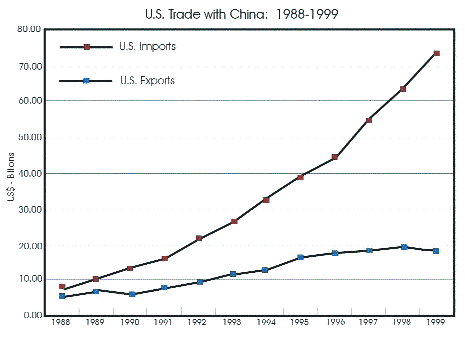
Dollar values of U.S. imports from and exports to China from 1988 to 1999The report
continued: It is vital that the WTO be reformed in order to ensure that competition is open and
fair. As a first step, the U.S. government must continue to reject efforts by developing nations to
increase U.S. access at a time when these very countries refuse to open their markets to U.S.
exports.ATMI opposed the granting of permanent Ntr to China and is against the acceptance of China
into the WTO. Ultimately, the two actions could cost the United States up to 150,000 textile and
textile-related jobs, $7.6 billion in lost apparel sales and $4 billion in lost textile sales,
Chastain said.This preferential treatment [Ntr status] will do nothing to change Chinas outlaw
behavior, nor will its membership in the WTO, he said. In fact, WTO membership will severely limit
the United States ability to act unilaterally to attack Chinas smuggling of more than $4 billion of
textiles and apparel into the United States each year. China has signed six bilateral textile trade
agreements with the United States and has broken every one of them. In addition, because the United
States has agreed to consider China a non-market economy, China will be able to continue to exploit
a loophole in the U.S. trade regulations and escape the U.S. countervailing duty law against export
subsidies. Let me stress that all U.S. manufacturers and their workers, not just those in textiles,
will be sitting ducks for Chinas subsidized exports.Why Support Chinas WTO MembershipIf the ATMI
stance is, indeed, a harbinger of things to come, why would anyone support Ntr status and WTO
membership for ChinaPresident Bill Clinton, in a statement after the Senate vote, said Ntr for
China will extend economic prosperity at home and promote economic freedom in China, increasing the
prospects for openness in China and a more peaceful future for all of us.The President, though,
stopped well short of echoing the position of those who aggressively support China and claim that
Ntr and WTO membership is a virtual guarantee of enhanced access by the United States to Chinese
markets. Ntr status will give the United States a chance not a certainty, but a chance to
strengthen our prosperity and our security and to see China become a more open society. Now our
test as a nation is whether we can achieve that. I hope and I strongly believe we will.When we open
markets abroad to U.S. goods, we open opportunities at home, the President said. [Ntr] will do
that. In return for normal trade relations China will open its markets to American products from
wheat, to cars, to consulting services. And we will be far more able to sell goods in China without
moving our factories there. But there is much more at stake here than our economic self-interests.
Its about building a world in which more human beings have more freedom, more control over their
lives, more contact with others than ever before a world in which countries are tied more closely
together, and the prospects for peace are strengthened.Trade alone wont accomplish this, Clinton
said, but bringing China under global rules of trade is a step in the right direction. The more
China opens its markets to our products, the wider it opens its doors to economic freedom, and the
more fully it will liberate the potential of its people.
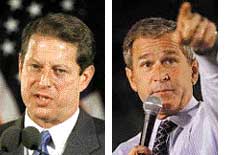
He continued, When China finishes its negotiations and joins the WTO, our high-tech companies
will help to speed the information revolution there. Outside competition will speed the demise of
Chinas huge state industries and spur the enterprise of private-sector involvement.Vice President
Al Gore, the Democratic nominee for President, and Texas Governor George W. Bush, the Republican
nominee, both agreed with Clintons stance on China.[Ntr for China] will mean more good jobs for
American workers and more opportunities for American farmers and businesses, Gore said. Passage of
[Ntr] is important for our economy and our security, but it is only part of what we must do to
assure that Americas workers and interests will fully benefit from the global economy. We must
combat unfair trade practices abroad when they harm our working families. We must also be vigilant
in monitoring Chinas record on human and worker rights, non-proliferation and protection of the
environment.Said Bush: The stakes are high on all sides. For businesses, workers and farmers from
across our country, it will mean much lower trade barriers and enormous opportunities for U.S.
exports. For the people of China, it holds out the hope of more open contact with the world of
freedom. Trade with China serves the economic interests of America.No Division Along Party
LinesThis is one issue, though, that has no division along party lines. Those Senators and
Representatives who opposed the measure, while in the minority, did so vehemently.Sen. Jesse Helms,
R-N.C., called permanent Ntr for China the most ill-advised piece of legislation to come to the
Senate floor in my 28 years as a Senator. Will granting permanent most favored nation status to
Communist China advance the foreign-policy interests of the United States My genuine conclusion is
that by doing so, the United States Senate [made] a mockery of common sense. Communist Chinas
foreign policy has become increas-ingly antithetical to U.S. national interests during the past 20
years of so-called nor-mal trade relations. It is difficult to see how making the status quo
permanent will cause any improvement.Senator Ernest F. Hollings, D-S.C., a past Presidential
can-didate, opposed the legislation, saying Ntr, despite assur-ances otherwise, will likely
increase imports without providing increased exports and is likely to further the migration of some
U.S. industry offshore.U.S. Rep. Nancy Pelosi, D-Calif., in testimony before a House Ways and Means
subcommittee, said the Ntr designation begs the question of what normal trade relations are or
should be.Is trade with China normal when the U.S. trade deficit with China is surging every year
Is it normal that China continues to maintain barriers to U.S. goods and services entering the
Chinese market, including high tariffs, pervasive non-tariff barriers, non-transparent barriers,
non-transparent trade rules and regulations; restrictions on trading and distribution rights,
restrictive government pro-curement practices and restrictions on investment Is it normal that
China continues to pirate U.S. intellectual property, costing U.S firms an estimated $2.6 billion
in lost sales in 1998 and that China continues to utilize forced labor for production of exports to
the United States, in violation of U.S. lawShe continued, For 10 years, advocates of permanent
[Ntr] status have argued that economic reform would lead to political reform in China and that U.S.
exports to China would increase. Political reform has not happened in China. And, the increase in
U.S. exports to China as a proportion of total U.S. exports has been so small as to be practically
insignificant. In 1989, she said, U.S. exports to China totaled 1.65 percent of U.S. exports
worldwide. By 1998, that figure had grown to only 2.1 percent. Chinas trade surplus estimated to be
$85 billion this year enables the country to buy products, to buy political support and to buy
silence from countries throughout the world.Opportunities For U.S. TextilesWhat some see as a
potential economic disaster, others see as a potential windfall. Consider the case of Harold Hoke,
the new CEO of American Savio and Somet of America, both headquartered in Spartanburg, S.C. Hoke
shared his views about China in an interview with ATI (See Vision, Innovation Are Keys To
Viability, ATI, August 2000).Is this a potential problem for the U.S. industry he asks. Sure it is.
But more than that, it represents a real opportunity. China is, of course, a huge market, and not
all of it is captured by low-end products. There is demand in China an increasing demand for
high-fashion products of world-class quality. So in many ways, this could be a very good thing for
those American companies that will take advantage of it. I certainly would not be afraid of it
unless I didnt really understand it and didnt have a plan to capitalize on it.And there are,
indeed, provisions within the U.S.-China WTO agree-ment, negotiated in November 1999, that give the
United States certain enforcement rights, according to a policy brief published by The Brookings
Institution. Especially, the agreement contains a mechanism that allows the United States to
prevent textile import surges until the end of 2008. As well, it allows the United States to
continue to treat China as a non-market economy in anti-dumping cases for 15 years after Chinas
acceptance into the WTO. This generally results in the application of larger anti-dumping margins
against Chinese imports. The agreement per-mits the United States to implement for 12 years
product-specific safeguards to prevent large non-textile import surges from China and allows the
United States to impose harsher import restrictions on China than on other WTO members.Free Trade
Versus Fair TradeFree trade is, of course, the unfettered movement of products from one market to
another. Many proponents of Chinas WTO accession cite this as the most likely result of opening a
market that has 1.3 billion potential consumers. It promises, they say, to be a boon for industry
and agriculture and, perhaps, provides a means to instigate sweeping social changes within Chinese
society.Fair trade is the equal application of tariffs and other trading considerations among
partners in commerce, enabling products from one country to compete profitably with those from
another. It is the application of this principle that prompts most non-moralistic objections over
Chinas entry into the WTO. Of course, the 1989 massacre in Tiananmen Square, and other human rights
violations, provide ample reason for many to oppose trade with China. But textile leaders and
organizations such as ATMI see the likelihood of Chinese circumvention of trade agreements and an
American government unwilling to aggressively enforce its treaties. They see only lost jobs, closed
plants and the further erosion of one of Americas key industries.In the end, it is a matter of
perspective and philosophy. There is no doubt that Chinas entry into the WTO will create a wealth
of opportunity for some.But for others
November 2000
Speed Weaving
Speed Weaving
Multiple weft insertion, advanced drives propel weaving machines to new heights of productivity
and efficiency. It wasnt so long ago that uniformly green, clacking, creaking,
fly-shuttle looms lined the weave rooms of American textile mills in seemingly endless columns,
pounding out yard upon yard of fabric in a laborious, raucous process that substituted sheer volume
for efficiency. The United States can credit these looms, along with the furnaces of Pittsburgh and
the assembly lines of Detroit, for its ascendancy to the pinnacle of world economic power.Those
were days of high adventure in American textiles. Every now and again, a shuttle deviated from its
assigned mission of weft insertion, escaped the shed and was launched on an uncontrolled flight
across the weave room, providing perhaps the first definition of projectile weaving. Those also
were the days when Americas staple product was borne from the take-up rolls on the backs of
broad-shouldered cloth doffers, and loom fixers resembled automotive mechanics more than computer
technicians. Quiet, relatively vibration-free machines, automated processes, and speeds in excess
of 1,000 picks per minute might well have been the subjects of science fiction novels.Then, some
bright engineer decided to take a look at the method of weft insertion and well, suffice it to say
that things changed. A weaver transported from a 1960s greige mill wouldnt recognize the smooth,
svelte machines at modern plants today. But, more to the point, a weaver from an early 1990s
environment might find himself equally as lost in the weave room of 2001.A number of companies have
new offerings in weaving machines, and most claim their products herald the dawn of a new era in
fabric production. Somets Mythos was reviewed in these pages several months ago (See Vision,
Innovation Are Keys To Viability, ATI, August 2000), and the products of other manufacturers will
be the subjects of future articles. In this issue, ATI provides a look at new concepts from two
leading manufacturers in Europe.The process of weft insertion provided the first major stumbling
block to increases in weaving speed. The fly-shuttle looms of the previous era could run only so
fast with any semblance of control over the process. Then came the first projectile looms, rapiers
and air-jets.Multi-Phase Weaving With Sulzer’s M8300Sulzer Textil, Switzerland, has taken the
concept of high-speed weft insertion a step further with the introduction of its multi-phase
weaving machine, the M8300.Single-phase weaving, traditional projectiles, rapiers and air-jets have
pushed the envelope, both in textile and technical limits, in what we can do, explained Louie
Dejonckheere, vice president, marketing, for Sulzer Textile Inc., the Spartanburg, S.C., unit of
Sulzer Textil. Improvements in insertion rates are limited by textile and technological factors,
particularly when processing spun staple yarns, he said. These limits are caused, in part, by
incompatible stressing of the threads and by uncontrollable physical conditions. When Sulzer began
looking at new technologies to improve efficiency and performance, we began exploring the
possibilities of multiple weft insertions.The concept of multiple insertions is not new. Research
dates back more than four decades to 1955, but finding a practical method of bringing concept to
reality proved a daunting task. Multiple shed formation can be accomplished with two basic
techniques, wave-shed and multi-linear. In wave-shed, the sheds are formed in the direction of the
weft, while multi-linear insertions require the sheds to be formed in the direction of the warp.
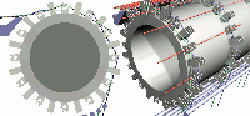
Initial concentration was on the wave-shed technique. At ITMA 75, four manufacturers
including Ruti (which had not yet been integrated into the Sulzer group), presented developments in
wave-shed techniques. By ITMA 83, three manufacturers were still demonstrating this technique, but
technological obstacles prevented the concept from achieving market success.On the basis of
experience drawn from our long-standing research, the wave-shed development failed because of
several inherent shortcomings, Dejonckheere said. Among those were: the impossibility of repairing
mispicks; differing weft-thread tensions as a consequence of several weft-yarn carriers being
activated at the same time; the requirement of an additional rewinding process caused by the
special make-up of the weft carriers; restriction to output-limited mechanical weft carriers; and
the failure to achieve the required beat-up necessary to obtain uniform insertion across the entire
weaving length.As a logical conclusion, arrived at with the experience we collected, Sulzer began
considering the multi-linear shed strategy for implementing multi-phase weaving, Dejonckheere said.
The M8300 is the result.The M8300, designed exclusively to be a single-warp machine, is earmarked
for mass-production commodity fabrics. Technological design at this point does not yet allow for
multiple-color, patterned insertions. The machine is installed in production capacity in several
locations throughout the world, including the United States. The M8300 has four sheds open at all
times, resulting in a machine that is technically capable of running from three to four times as
fast as a typical air-jet machine, Dejonckheere said. Weft insertion rates of up to 6,000 meters
per minute are possible, as Sulzer demonstrated at ITMA 99 in Paris. This concept truly extends the
boundaries of fabric production, he said.The M8300 has a complete modular design for ease of
installation, operation and maintenance, according to Dejonckheere. The machine is divided into a
weaving module, warp module, shedding module, cloth-winding module and yarn-feeding module. This
arrangement guarantees warp and cloth run-off optimized for ergonomics and facilitates a quick warp
change. The machine accommodates warp beams of up to 1,600 millimeters, which allows processing of
large batch lengths.Shed Formation And Weft InsertionThe multi-linear shed formation opens four
sheds across the entire weaving length. The parallel sheds are opened in the warp direction, one
behind the other. One thread is inserted into each shed to allow the simultaneous weaving of four
picks. Unlike the wave-shed method, every missed pick can be detected and repaired, Dejonckheere
said.The individual sheds are form-fit across the circumference of a weaving rotor, anchored by
shed-holding elements arranged in a line. Spreading the warp threads on the shed-holding elements
is achieved with the aid of warp positioners similar to the needle bars of knitting machines. The
quantity of required warp positioners depends upon warp density.
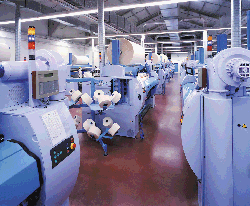
Weft insertion is accomplished with a low-pressure blast of air through a weft channel formed
by the shed-holding elements. Additional relay nozzles are placed within the shed-holding elements.
The weft threads are continuously unwound through metering rollers from four stationary packages.
Constant thread velocity can be controlled according to weaving width, insertion rate and the speed
of the metering rollers. Thread velocity amounts to only 20 meters per second at an insertion rate
of 5,000 meters per minute. Weft threads are fed to a weft-processing unit, which controls
distribution. The weft-processing unit consists of two concentrically arranged disks in a
multi-channel system. The threads leave these guiding channels in a synchronized sequence and enter
the appropriate weft channel. Between the weft-processing unit and the weft channels are a thread
clamp and the main cutter. The four weft yarns are then transported very gently through their
respective sheds in a staggered sequence by a compressed air stream of only 25-30 psi.On the
receiving side, arrival of the weft thread is electronically detected, and combs positioned on the
circumference of the weaving rotor accomplish weft beat-up. These combs are located between two
rows of shed-holding elements and replace the function of conventional weaving reeds.Single-Motor
ControlThe M8300s individual motor control allows optimum support of the modular weaving system,
according to Dejonckheere. All motions are freely programmable to ensure adaptation to weaving
requirements. The actuating concept of the M8300 features an electronic guiding shaft with no
moving parts. The guiding shaft position is transmitted to all drives via a tact bus. Each drive
has an electronically controlled coupling and gearbox with programmable transmission ratios and can
be operated either synchronously or asynchronously in any direction of rotation. This allows for
absolute freedom in the spatial arrangement of drive shafts, he said, and provides for the
programmability of all motions via software. Ultimately, one has the possibility of optimizing
operability and weaving automation without either conversions or additional hardware.Because of the
low velocity of weft insertion, weft-thread stress is considerably lower than in single-phase
air-jet machines, even though ultimate insertion rate is substantially higher. Despite
two-and-a-half times higher production rates, this weft-insertion system reduces the maximum weft
velocity by approximately 75 percent, compared to single-phase air-jet weaving machines, he said.In
addition to much higher insertion rates, Dejonckheere said the M8300 reduces noise levels by up to
50 percent over conventional air-jet machines and consumes less power. Self-contained
air-conditioning reduces heat build-up, waste and airborne particulate matter.The M8300 multi-phase
weaving machine is a milestone in technology, he said. For standard fabrics, we believe it is the
most economical weaving system currently available. Picanol Focuses On Production
FlexibilityWhile Sulzer has been focusing on multi-phase weaving for large runs of commodity
fabrics, Belgium-based Picanol NV continues to optimize its line of air-jet machines for smaller
production runs.Just under a decade ago, Picanol introduced its revolutionary Omni air-jet weaving
machine based on the fast-response philosophy, said James C. Thomas, president, Picanol of America
Inc., Greenville, S.C., the U.S. subsidiary of Picanol NV. Weve been working to enhance economical
production of relatively small batches at high speed, with the capability to make frequent style or
warp changes. We consider this to be the textile industrys answer to lean, flexible
manufacturing.Earlier this year, Picanol expanded upon this concept with the launch of the OMNIplus
machine (see New Products, ATI, September 2000).
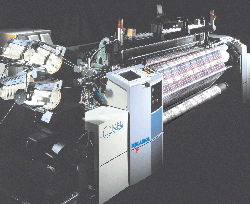
The two starting points for development of the OMNIplus were the fabrics to be produced and
the weavers job, Thomas said. On one hand, the machine had to be able to produce high-quality
fabrics in a very wide application range and at competitive prices. On the other hand, it had to
enable the weaver to meet varying market demands in a flexible, user-friendly way. These, then, are
the key features of the OMNIplus: higher quality at lower cost coupled with production flexibility
and user-friendliness.The OMNIplus weaves spun, filament and a wide range of fancy yarns
high-twist, stretch, chenille and textured yarns in up to six colors and yarn types. For the weave
pattern, there is a choice of positive cam, positive dobby or jacquard motion. Available reed
widths include 190, 220, 250, 280, 340, 380, and 400 centimeters. The OMNIplus can produce cloth
rolls of up to 720 millimeters or 1,500 millimeters with the Picanol Batching Motion. Sumo
Drive MotorPerhaps the biggest innovation associated with the introduction of the OMNIplus is
Picanols Sumo drive motor, which is based on switched reluctance technology. Sumo derives its name
not from the famed Japanese wrestlers although Picanol uses the image in its marketing efforts but
from the first two letters in the words super and motor.The Sumo motor drives the weaving machine
directly, Thomas said, without the clutch-and-brake units. This is an enormous contribution to
reliability, he said. Moreover, the extremely fast response time its on the order of milliseconds
makes it possible to automatically vary the speed of the motor during the weaving cycle to suit
each and every pick. The variable speed of the Sumo is set electronically. The Flexispeed version
of the motor, which is standard on the OMNIplus, enables the speed variation to be set in
distinctive steps when the machine is stopped. The optional Multispeed version permits continuous
speed adjustment during weaving. A third option, the Optispeed version, allows automatic variation
according to color and weave pattern.
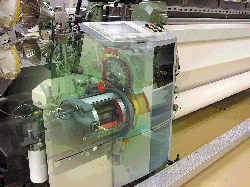
The principle of the switched reluctance motor, according to Picanol, dates back more than a
century to the early days of electromagnetic technology. The rotor is merely a lump of iron, with
no permanent magnets or windings. The stator consists of slots containing a series of coil
windings, which are energized by electronic switching to generate a moving magnetic field.While the
basic concept is extremely simple, Thomas said, the switching necessary to obtain top performance
at an acceptable price has been, previous to this development, too complex.In addition to the Sumo
motor, the OMNIplus features a flexible insertion system that enables the speed to be
electronically controlled to suit the filling material and the weave pattern, he said. With
Picanols Quick Style Change system, a style change can be carried out in less than 30
minutes.Yarn-friendly insertion is achieved with separate controls of both the fixed and movable
main nozzle, the low-friction presentation of the yarn, the filling tensioner and the motion of the
sley, Thomas said.Energy consumption is estimated to be 15 to 20 percent less than comparable
machines, and air consumption is lower because of a reduced pressure drop in the air distribution
system. Productivity Enhanced By Technological InnovationsThese offerings, in combination
with advanced weaving machines and systems from other manufacturers that will be explored in
upcoming issues of ATI, are poised to have significant impact on the productivity of American
textile plants, as well as those throughout the rest of the world. What has been a steady evolution
in single-phase technology is becoming, with the advent of multi-phase insertion, a revolution,
according to Sulzers Dejonckheere.We began working on multi-phase technology many years ago, he
said. And we are constantly looking at pushing the edge of the envelope of applications as far as
it will go.Its all about meeting the customers needs, says Picanols Thomas. Its about close
collaboration, advanced production methods and extensive test programs. These are the factors that
have led to the advanced Picanol machines of today and will lead to even more advancements
tomorrow.
November 2000
Rugs Offer Styling Options
Rugs Offer Styling Options
Emerging trends and colors are translated into rugs designed to coordinate with surrounding
furnishings.Home furnishings designers and colorists are having a field day with accenting
rugs to correspond with furniture, walls and windows throughout the home. Its a fact people should
be comfortable in their own homes, living with surroundings that reflect their tastes. The way a
home is furnished should also fit the lifestyles of those living there, while making it
comfortable, functional and attractive. In todays scheme of things, just about anything goes. Its
mostly about a homeowners personal choice and preference. Results can come from a complete
re-modeling, new paint and/or carpet, rearranging existing furniture, or just adding a rug to
exactly the right place, in precisely the right color.Beaulieu® Knows Rugs
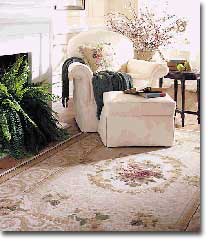
Perhaps adding a rug as an accent to existing decor has become the preferred method of
augmenting the ambiance of a home as evidenced by the rapidly growing demand in the United States
for area rugs. Beaulieu Home Fashions, Dalton, Ga., a division of Beaulieu of America, has been an
instrumental force in the development, design and manufacture of these products. In fact, Beaulieu
Home Fashions pioneered the affordable oriental rug by producing in-demand designs using
proprietary polypropylene (olefin) yarn systems along with its high-tech computer-aided design
capabilities. Beaulieu of America had its beginning in 1959 in Belgium. The name Beaulieu is French
for a beautiful place. The first rugs bearing the Beaulieu trademark were woven in 1962 in Belgium.
By 1978, rugs were being woven in Dalton, Ga., independently of the European operation. The company
manufactures a unique and exclusive line of area rugs, according to Janice Stern, graphic designer,
Beaulieu Home Fashions. She said these rugs are styled in colors relevant to home decorating
trends, with careful attention paid to todays popular themes, patterns and fabrics. They have been
designed to complement other furnishings in a room with warmth, pattern and color.Laura Ashley,
Waverly and Raymond Waites are names used for Beaulieus brand name collections. The Laura Ashley
line has fine-quality area rugs designed to coordinate with many of the colors in the Laura Ashley
Color Collection of interior paints. The firms Silver Label Collection is designed by Raymond
Waites. These rugs are machine-woven from premium Beaulon® olefin yarns using a double-point
weaving technique that adds an embossed appearance to each of the patterns. Double pointing allows
an illusion of many colors made from only eight colors. The rug is twice as thick in the places
where double pointing is used because two tufts of yarn per pick are used instead of one.Each of
the rugs is serged on all four sides and is available in five different sizes. The Waverly®
Royalton Collection is a 100-percent DeepWeave® Plus olefin pile and is available in five different
sizes: 2 feet by 4 feet, 2 by 8, 5 by 6, 6 by 9, and 9 by 12.Stern noted that Beaulieu uses a
variety of fabrics, styles and designs, from old-world designs to modern prints. There can be up to
eight colors in the woven rugs, but double pointing can give the effect of up to 36 colors. In some
cases, the colors in a rug are used for inspiration in decorating an entire room.In our Jewel
Collection, you will see that historic designs from Europes grandest eras have become todays most
interesting and appealing area rugs, Stern said. She gave as examples timeless architectural motifs
from the Golden Age of Greece, heraldry from the crusading knights of the Middle Ages, French
symbols of royalty and revolution, and the beautiful Chinese fabrics discovered by Syrian traders.
All are redefined into new designs reminiscent of fine Axminster carpets found in the grand
European ball-rooms and palaces of earlier times.Trends
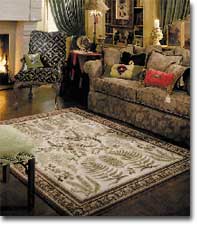
Robin Cole, a colorist for Beaulieu Home Fashions, understands how the transition is made
from individual elements to a complete home furnishings pack-age. In determining the focus of the
coming year, Cole explained, the emerging trends from areas such as bedding, fabrics, upholstery,
furniture, wallpaper, bath, accessories and fashion are studied. Womens fashion is always
interesting to watch because a lot of trends in design and color begin here, Cole continued. At
this point, Cole translates design ideas from home furnishings to rugs.The botanical look with a
tropical tone is emerging as a strong trend, she said. Bamboo, palm leaves, pineapples, palm trees,
orchids and textural fabrics are used with distressed woods. Animal prints are still popular;
leopard, tiger, pony, snake, giraffe, and zebra are often used with bright colors such as hot pink,
aqua and day-glow yellow. The animal-skin trend is present in just about everything from fashion to
home furnishings.The botanical look is a new version evolved from the Asian theme that has peaked
and now is decreasing in popularity. However, Cole said, interest in the Asian theme, while
declining, will still command some market attention over the next year or so.African motifs are
also being seen. Everything from elephants to monkeys is popular, including cheetahs, leopards,
giraffes and camels. Feathers are trendy and are being used on lampshades, frames, pens and floral
arrangements just about anything that can be imagined.Patterns, according to Cole, will be making a
comeback. After years of textural fabrics being so popular, pattern is beginning to reappear, she
said. It has been seen in many current fashion collections and is called the Pucci look [after
Italian designer Emilio Pucci, whose patterned, brightly colored fashions were popular during the
1960s]. How this will work its way down to the home furnishing sector will be interesting to
discover.French and English country designs also are emerging as trends, she said. Toiles, florals,
plaids, stripes and checks are plentiful, as well as realistic floral motifs that are upscale and
more sophisticated than in the past. There appears to be a more traditional look on the scene and
[these motifs] should be appearing in the next six to 12 months. However, she doesnt think it will
be the stiff, formal look of the past, but rather a look that will mix well with the casual themes
seen over the past couple of years. This look will show up, she said, as traditional florals and
leaf designs, but just a little more simplified. Damask and less complicated conventional looks
will be seen.ColorsColor preferences, of course, wax and wane with the finicky and fickle taste of
the consumer, with some seasons featuring fashions in bright primaries, while others see more
subtle, muted tones. Cole discussed some of the colors currently shaping fashion in home
furnishings. For the next home furnishings season, she sees blues gaining ground in popularity in
light to mid-tone hues and in shades infused with green.Black is coming back. It will be used as a
base and could be in response to the re-emergence of a 1980s trend that is showing up in various
fashions this year. Red has been popular and will continue. There will also be shades of
terracotta, orange, melon and, especially, copper.An exotic palette to support the botanical,
tropical look includes water blues, peacock, leaf-green shades, ripe melon and sand. Warm purples
mixed with greens will show up as iris, dusk, cloud, aloe and sage. Tans accented with warm muted
gray-blues will include hazelnut, mudslide, silver fox, lapis and slate.Colors within palettes
complement each other and will have sophisticated blends of color rather than contrasting tones.
Rich, aged cultural colors will be plentiful in gold, truffle, desert, spice, caviar, artichoke,
olive, mustard, harvest, clay, russet and cinnamon.Rug Fibers
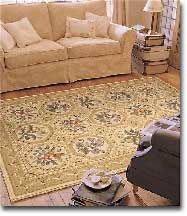
Aside from the plethora of colors and patterns from which to choose, another important factor
in the design of rugs is construction. In earlier days, fibers usually were chosen because they
were native to the place where rugs were woven. Sheep raising was widespread, so wool became the
chief carpet and rug fiber. In the Far East, silk was also woven into rugs and hangings. The hair
of such animals as goat, camel and alpaca was used in certain areas. Cotton, jute, and linen have
also been used. Today, carpets and rugs are made from both natural and man-made fibers. Wool
remains popular, but nylon has been used more frequently in the United States since the 1960s.
Cotton has been used primarily for scatter rugs.The leading man-made fibers are filament and staple
nylons; acrylics and modacrylics; rayon and polypropylene (olefin); and polyester. These fibers,
although they are the same generic types used for apparel and other furnishings, are produced
especially for flooring use. There are different grades of density and pile. Man-made fibers are
colorfast, non-allergenic and easy to clean.Rugs are often used by those homeowners who want to add
a designers touch for decoration but are on a budget. Olefin fibers are used for both pile and
backing. Many synthetic and natural fibers are also used to make decorative carpet wall
hangings.Rugs And Carpets DefinedFloor coverings of all types are found in homes, offices,
churches, restaurants, stores, schools, offices, and other settings. These floor coverings range
from wall-to-wall carpet and hard-surface flooring to a large variety of rugs. Rugs, as mentioned
previously, are being used more and more in homes because they are rich in color and design and
offer many styling options.Sometimes the terms carpet and rug are used interchangeably. Carpet
usually is referred to as a wall-to-wall floor covering that has been installed. The two main types
of carpeting are flat-woven and pile (woven and tufted). In woven pile carpets, pile yarns and
backing yarns are interlocked simultaneously. In tufted carpets, pile yarns are attached to a
pre-constructed backing. Pile carpet is the most widely used.A rug, in general, is a textile floor
covering that is not fastened down. In home furnishings, rugs are used as accents and decoration.
In addition, rugs are used not only over wood, ceramic, and hard surface flooring but often a
designer rug is spread over wall-to-wall carpeting.Pile rugs, like pile carpets, have strands of
yarn standing erect from the carpet backing to create a soft, luxurious surface. The pile may be a
loop of yarn or a yarn tuft with free ends. The thicker and denser the pile, the more wear and
service may be expected.Other types of rugs include handwoven rugs, which also include Oriental
rugs.Having a warm and inviting home can be achieved by combining the right design elements that go
into creating a comfortable feeling. Choosing the right type of rug can be a matter of personal
option, although many homeowners seek help from an interior designer. Handwoven RugsAlthough
power machinery turns out most of the carpet and rugs sold today, it has not eliminated the ancient
craft of handweaving. Most handwoven rugs are Orientals, made in the Middle and Far East. Many are
produced in Turkey, Iran and the Central Asian countries to the north and east of Iran, such as
Turkmenistan, Tajikistan, Uzbekistan, and Azerbaijan formerly part of the Soviet Union. Specific
styles (characterized by local motifs, colors and weave qualities) include Bokhara, Tekke, Yomud,
Sarouk and Salor, among others. Samarkand rugs are woven in Chinas Xinjiang Uygur Autonomous
Region. With the rise of communism in China, however, the weaving and export of handmade rugs
declined.Oriental rugs are usually classified geographically as Persian, Turkish, Caucasian,
Turkoman, Indian, or Chinese. Varieties within these groups may be named for towns in the various
weaving districts often for their marketing centers. Traditionally, Oriental rugs are woven on
upright frame looms consisting of four poles.The weaving methods have not changed in centuries. The
warp threads are stretched lengthwise from top to bottom around rollers or beams. The weaver sits
on a board facing the loom. To make the silky pile for which these rugs are famous, the weaver
loops pieces of yarn to tie knots around the warp threads. A pattern hanging behind the warp guides
the choice of colored yarns to fill in the design.After a row of knots is tied, the weft yarn is
shuttled across the rug, then beaten with a comb against the knots to hold them firmly. The knot
ends are clipped and stand erect as pile. However, in todays workplace environment, rugs for public
use are mass-produced using sophisticated carpet machinery.
November 2000
Resch In-Line Steamer From A B Carter
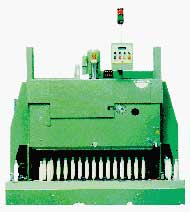
A.B. Carter Inc., Gastonia, N.C., has introduced the new Resch in-line steamer. This compact
system was designed for easy installation between any Link spinning frame and winder. The system
will automatically steam the bobbins for the purpose of relaxing yarn twist and controlling
residual moisture, resulting in higher yarn quality and lower manufacturing costs. The system works
with a variety of yarn types including worsted, wool, polyester and high-twist blends, as well as
100-percent cotton yarns.The Resch system operates cyclically with a capacity of up to 900 bobbins
per hour, using an indexing process in which the bobbins are steamed and subsequently dried in two
minutes or less. Both the steaming and drying processes are performed under precisely controlled
vacuum conditions. All functional sequence and temperature settings are computer-controlled and
monitored and can be preset using a system of dials. The steamer occupies less than 10 feet of
floor space.
2000
Sulzer To Divest Five Business Units Including Sulzer Textil
Switzerland-based Sulzer has announced plans to divest five Sulzer Industries business units,
including Sulzer Textil, in a move to focus the companys business activities on medical devices and
on surface and materials technology.In addition to Sulzer Textil, Sulzer will divest Sulzer Infra,
Sulzer Pumps, Sulzer Turbo and Sulzer Burckhardt and related distribution and service
organizations.The five units together represent approximately CHF 3.6 billion in revenues. More
than 14,600 employees, including 2,000 in Sulzer Textil are affected by the decision.Sulzer intends
to complete the divestiture as quickly as possible and has pledged to honor its obligations to its
employees. Sulzer Textil CEO Philip Mosimann and Christopher Somm, head of sales and marketing,
issued a statement in conjunction with the announcement, citing opportunities for the manufacturer
of weaving machines to reorient its own activities. In this new arrangement, we aim to strengthen
and extend our operations as a leading provider of weaving machines and associated services, they
stated. Sulzer Textil took a significant step in this direction more than two years ago when it
took over the weaving machine business from Nuovo Pignone Divisione SMIT, a unit of General
Electric.With the expansion of our product portfolio into rapier weaving machines, we massively
increased our market share. There has been a significant increase in sales and profits for the
current financial year compared with last year, and a remarkably higher number of orders received.
The restructuring that was introduced by Sulzer Textil management has now improved
profitability.Our new situation will allow the right conditions for continuing improvements in our
customer-focused activities, and successful further development of the company of this, the
management and employees of Sulzer Textil are convinced.
Consoltex-Sealtex Launches All Points Fabric Collection
Montreal-based Consoltex-Sealtex has introduced its All Points collection of fabrics developed
using Meryl® nylon from Milan-based Nylstar. The soft, lightweight, matte-look fabrics, constructed
of a 70/68, full-dull type 66 yarn, are available with sunblock protection and are targeted
primarily for outdoor apparel. The collection also includes Meryl/cotton blends.Meryl is highly
moisture-absorbent and offers almost four times more UV protection than polyester. It is also
nearly 30 percent thinner than cotton.
November 2000




